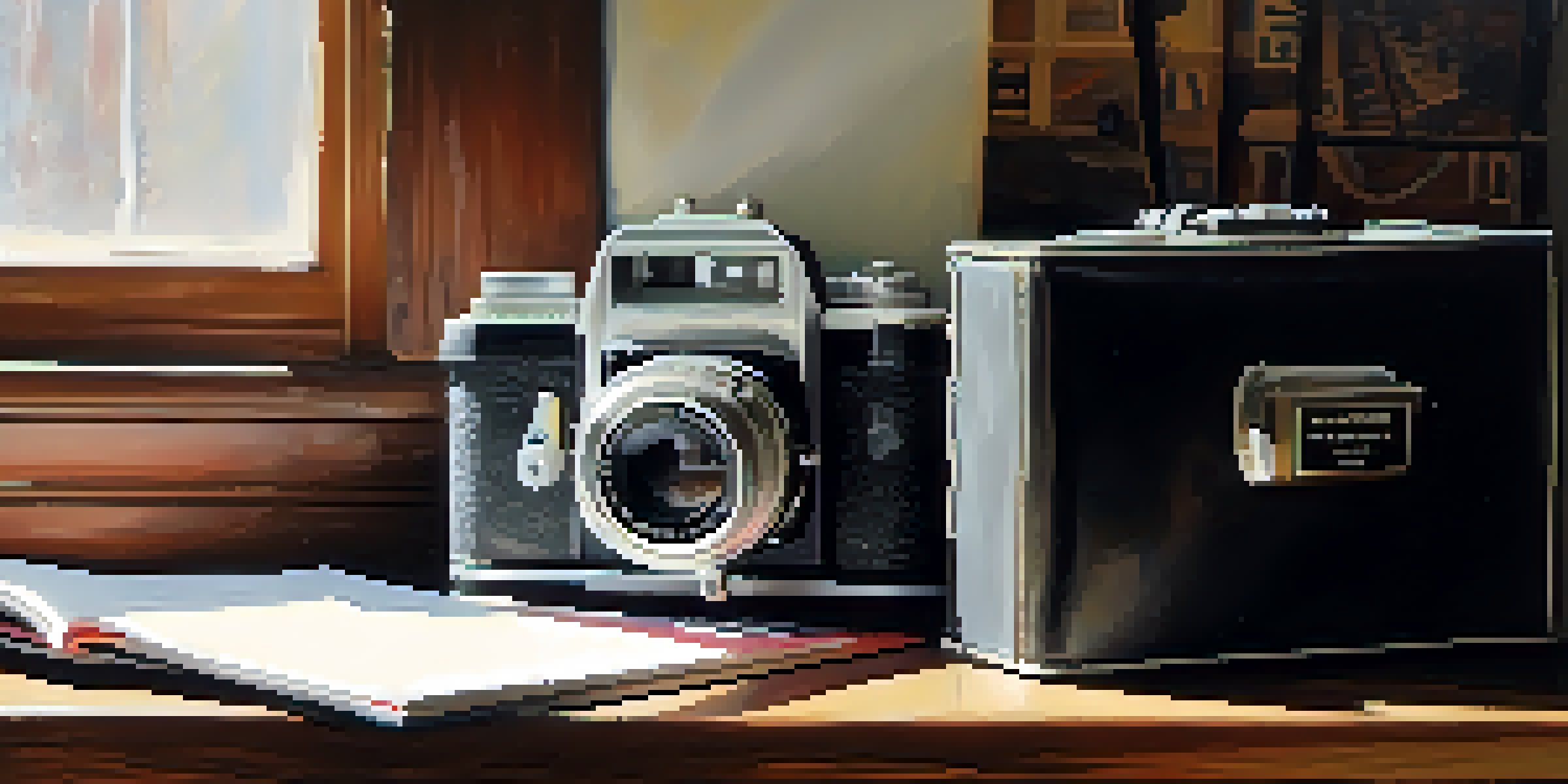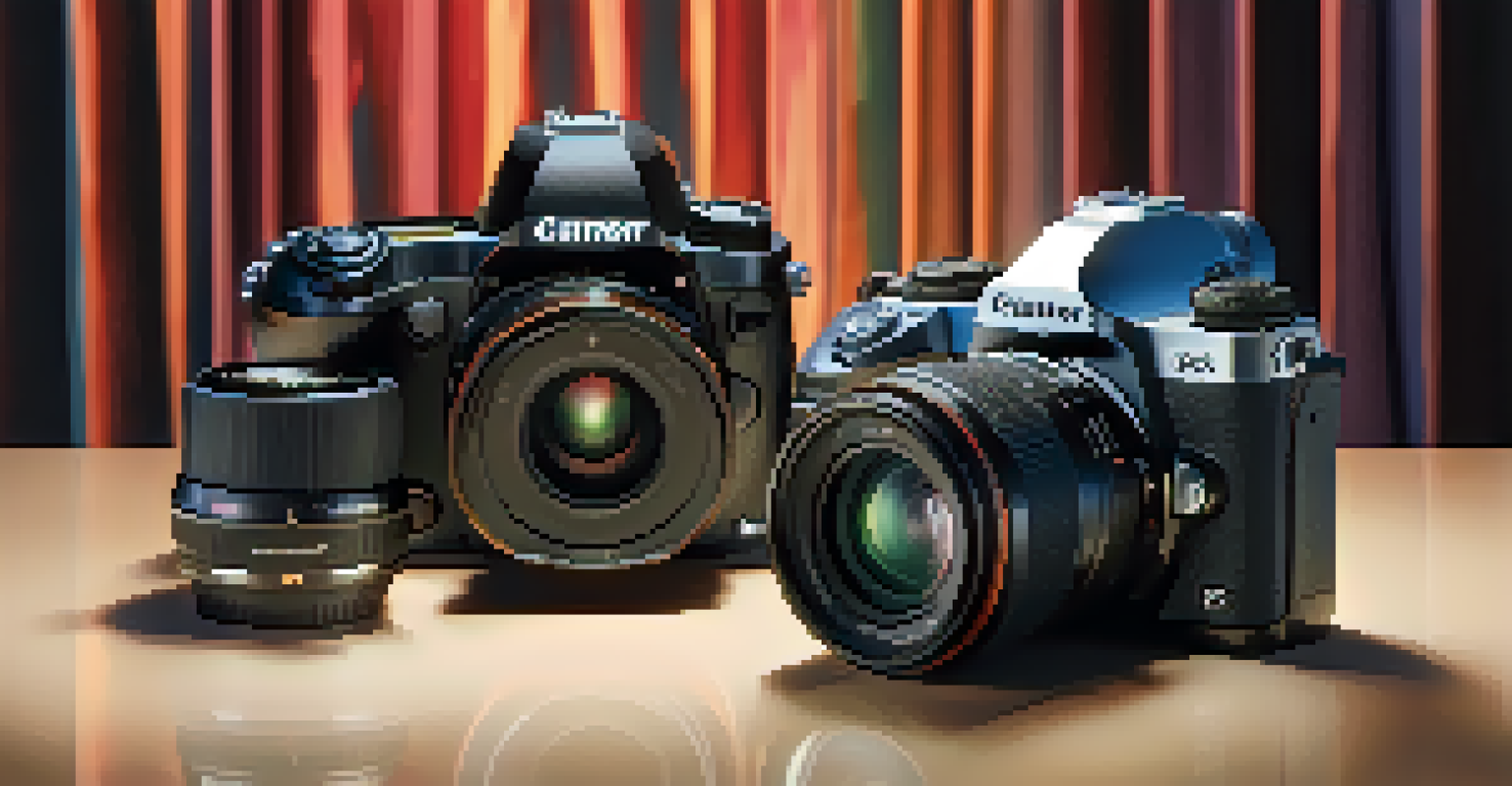The Evolution of Film Cameras: From Analog to Digital Formats

The Birth of Film Cameras: A Glimpse into History
Film cameras date back to the early 19th century, with the first successful photograph captured by Joseph Nicéphore Niépce in 1826. This marked the dawn of photography, where light-sensitive materials were used to create lasting images. Early film cameras were bulky and complex but opened the door to capturing moments in time.
Photography is the story I fail to put into words.
As technology advanced, cameras became more refined. By the late 1800s, innovations like roll film made photography accessible to the masses. This democratization of photography changed how people documented their lives, paving the way for amateur photographers to explore their creativity.
The introduction of color film in the 1930s was a game-changer, allowing photographers to capture the world in vibrant hues. With each advancement, the art of photography grew, leading to the creation of various styles and techniques that influenced generations of photographers.
The Rise of 35mm Film and Its Impact
In the early 20th century, the 35mm film format gained popularity, especially with the introduction of the Leica camera in 1925. This compact design allowed for more portability, making it easier for photographers to carry their gear. As a result, the 35mm format quickly became the standard in both amateur and professional photography.

The 35mm film's versatility allowed for a range of photographic styles, from candid street photography to staged portraits. Photographers like Henri Cartier-Bresson capitalized on this format, capturing iconic moments that defined the art of photojournalism. This era showcased how powerful a simple camera could be in storytelling.
Film Cameras: A Historic Journey
Film cameras have evolved from bulky 19th-century devices to more refined models, making photography accessible to the masses and inspiring creative exploration.
As the demand for 35mm cameras grew, manufacturers rushed to innovate, leading to a surge in features like automatic exposure and interchangeable lenses. These advancements not only enhanced the photography experience but also attracted a new generation of photographers eager to experiment with their craft.
The Advent of Instant Cameras: Capturing Moments on the Spot
The 1940s brought about a revolutionary change with the introduction of instant cameras, epitomized by Polaroid's iconic model. These cameras allowed users to click a photo and watch it develop right before their eyes, creating a sense of magic and immediacy. Instant photography quickly garnered a loyal following, especially among families and event-goers.
The camera is an instrument that teaches people how to see without a camera.
What made instant cameras appealing was their simplicity and the tangible result they provided. Unlike traditional film, which required processing, instant cameras delivered prints in mere minutes. This convenience transformed photography into a spontaneous activity, where capturing moments became part of the experience.
However, despite their charm, instant cameras faced competition from traditional film and digital advancements. Yet, they carved out a niche market, appealing to those who valued the physical print and the unique, often imperfect results that instant photography offered.
Transitioning to Digital: The Big Shift Begins
The 1990s marked the beginning of a significant shift in photography with the emergence of digital cameras. Instead of film, these cameras used electronic sensors to capture images, instantly changing how photographers approached their craft. Early digital cameras were expensive and offered lower quality than film, but they paved the way for future innovations.
One of the key advantages of digital photography was the ability to review and delete images immediately. This feature encouraged experimentation, allowing photographers to take more risks without the fear of wasting film. As technology progressed, digital cameras became more affordable and user-friendly, appealing to a broader audience.
Digital Shift: Revolutionizing Photography
The transition to digital cameras in the 1990s transformed photography by allowing immediate review and greater experimentation, ultimately leading to digital's dominance.
By the early 2000s, digital cameras had overtaken film in sales, signaling a monumental shift in the industry. As more people transitioned to digital, it became clear that this new format was not just a passing trend but the future of photography.
The Rise of DSLRs: Professional Photography Reimagined
The introduction of Digital Single-Lens Reflex (DSLR) cameras in the early 2000s revolutionized professional photography. With their combination of digital convenience and the optical quality of traditional cameras, DSLRs quickly became the go-to choice for professionals. Features like interchangeable lenses and manual controls allowed photographers to regain creative control over their shots.
DSLRs made it easier to capture high-quality images in various lighting conditions, making them ideal for everything from weddings to wildlife photography. This flexibility appealed to both seasoned professionals and aspiring photographers, leading to a boom in photography education and workshops.
As DSLRs gained popularity, they also encouraged a new wave of creativity. Photographers began experimenting with different styles, techniques, and post-processing methods, pushing the boundaries of what was possible in photography. This era marked a golden age for photographers looking to express their vision.
Mirrorless Cameras: The Next Evolution in Photography
In recent years, mirrorless cameras have emerged as a strong competitor to DSLRs, offering a more compact design without sacrificing image quality. By eliminating the mirror mechanism found in traditional cameras, mirrorless models are lighter and often faster, appealing to photographers who value portability. This innovation has made it easier for photographers to carry their gear on long shoots.
The technology behind mirrorless cameras has advanced rapidly, with features like electronic viewfinders and superior autofocus systems. These advancements have made them particularly appealing to videographers and content creators, who benefit from the ability to capture high-quality video alongside stunning stills. This versatility has expanded the potential for storytelling through photography and videography alike.
Film's Resurgence Amid Digital Dominance
Despite the rise of digital photography, film has experienced a revival as photographers seek its unique aesthetic and tactile experience.
As mirrorless technology continues to evolve, it’s clear that these cameras are shaping the future of photography. With brands investing heavily in research and development, we can expect to see even more exciting features that will redefine how we capture and share our experiences.
The Future of Film Cameras: Nostalgia Meets Innovation
Despite the dominance of digital cameras, film photography has seen a resurgence in recent years. Many photographers are drawn to the unique aesthetic and tactile experience that shooting with film provides. The deliberate nature of film photography encourages a more thoughtful approach to composition and exposure, offering a refreshing contrast to the instant gratification of digital.
Film has become a niche market, with the rise of vintage cameras and film stocks catering to a new generation of enthusiasts. Photographers are increasingly appreciating the imperfections and characteristics of film, which can add a layer of authenticity to their work. This trend highlights a growing desire for tangible, physical photography that digital formats often lack.

As technology continues to advance, the film community has found ways to innovate while honoring tradition. New film stocks and processing methods are being developed, bridging the gap between analog and digital. This harmonious coexistence suggests that both formats can thrive, each offering unique experiences and artistic opportunities.